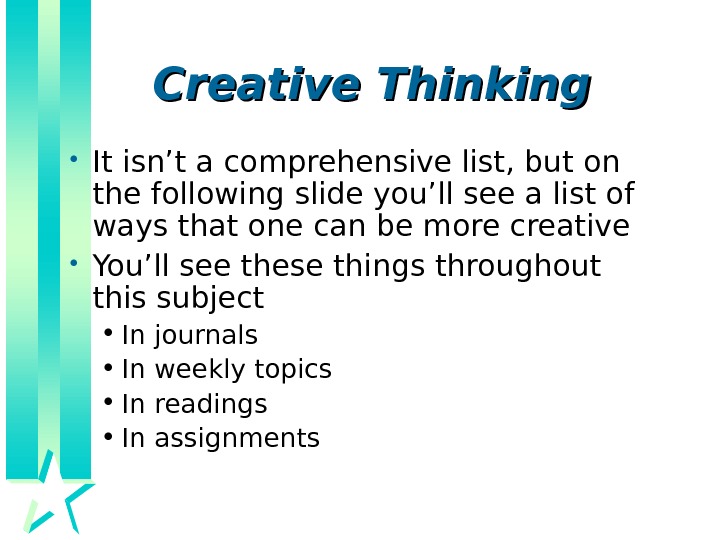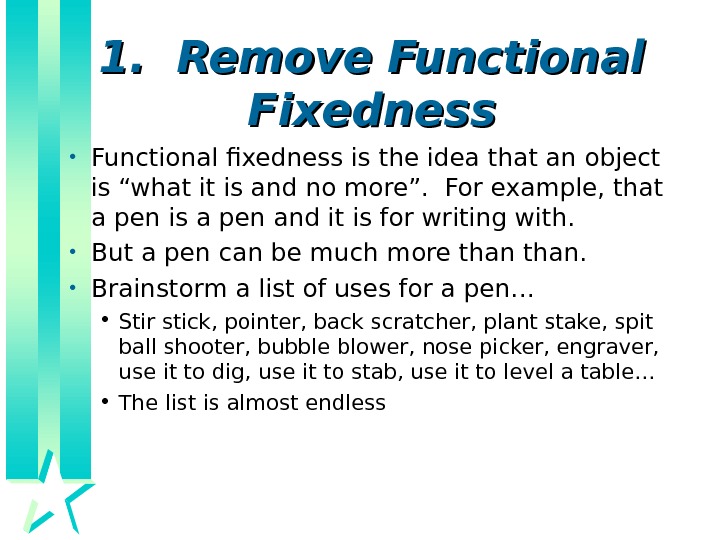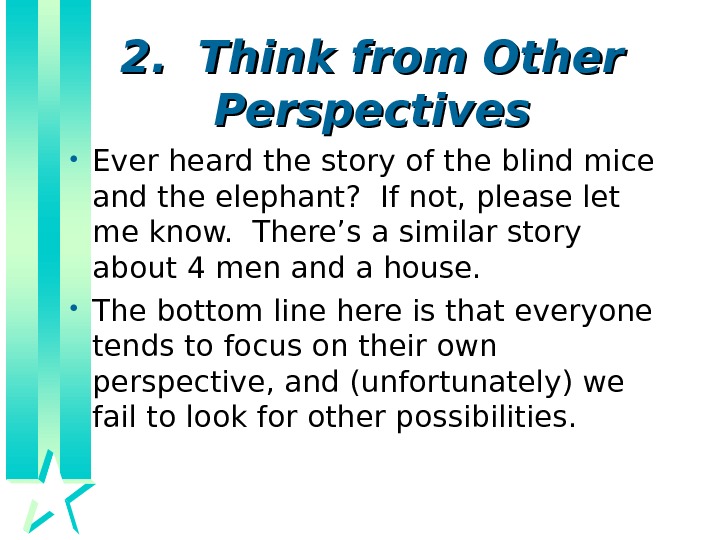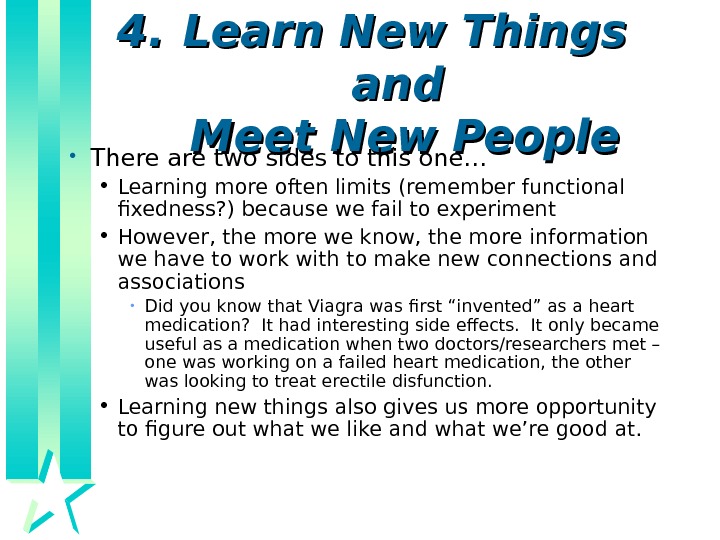How to Be More Creative An early explanation



















- Размер: 94 Кб
- Количество слайдов: 18
Описание презентации How to Be More Creative An early explanation по слайдам
 How to Be More Creative An early explanation of why we’re doing the journals and exercises that are contained in this subject.
How to Be More Creative An early explanation of why we’re doing the journals and exercises that are contained in this subject.
 Creative Thinking • A lot of being “creative” is about breaking habits and establishing new patterns of thinking. For every one of us, being more creative involves doing things in a different way than we currently do them. • Being more creative is fun, but it can also seem silly and even pointless.
Creative Thinking • A lot of being “creative” is about breaking habits and establishing new patterns of thinking. For every one of us, being more creative involves doing things in a different way than we currently do them. • Being more creative is fun, but it can also seem silly and even pointless.
 Creative Thinking • It isn’t a comprehensive list, but on the following slide you’ll see a list of ways that one can be more creative • You’ll see these things throughout this subject • In journals • In weekly topics • In readings • In assignments
Creative Thinking • It isn’t a comprehensive list, but on the following slide you’ll see a list of ways that one can be more creative • You’ll see these things throughout this subject • In journals • In weekly topics • In readings • In assignments
 How to be more creative… These are some key ways that one can be more creative 1. Remove functional fixedness 2. Think (and see) from other perspectives 3. Look for patterns 4. Learn new things and meet new people 5. Conquer your censor (fear of failure, fear of looking stupid) 6. Learn to make associations between seemingly unconnected things 7. Become more self aware 8. Learn creative problem solving techniques 9. Practice lateral thinking 10. Brainstorming
How to be more creative… These are some key ways that one can be more creative 1. Remove functional fixedness 2. Think (and see) from other perspectives 3. Look for patterns 4. Learn new things and meet new people 5. Conquer your censor (fear of failure, fear of looking stupid) 6. Learn to make associations between seemingly unconnected things 7. Become more self aware 8. Learn creative problem solving techniques 9. Practice lateral thinking 10. Brainstorming
 1. Remove Functional Fixedness • Functional fixedness is the idea that an object is “what it is and no more”. For example, that a pen is a pen and it is for writing with. • But a pen can be much more than. • Brainstorm a list of uses for a pen… • Stir stick, pointer, back scratcher, plant stake, spit ball shooter, bubble blower, nose picker, engraver, use it to dig, use it to stab, use it to level a table… • The list is almost endless
1. Remove Functional Fixedness • Functional fixedness is the idea that an object is “what it is and no more”. For example, that a pen is a pen and it is for writing with. • But a pen can be much more than. • Brainstorm a list of uses for a pen… • Stir stick, pointer, back scratcher, plant stake, spit ball shooter, bubble blower, nose picker, engraver, use it to dig, use it to stab, use it to level a table… • The list is almost endless
 1. Remove Functional Fixedness • Being more creative means removing functional fixedness, and using objects in ways that they weren’t really intended. • Being more creative means getting beyond ‘what should be’ and into what COULD be; it involved possibility, not probability.
1. Remove Functional Fixedness • Being more creative means removing functional fixedness, and using objects in ways that they weren’t really intended. • Being more creative means getting beyond ‘what should be’ and into what COULD be; it involved possibility, not probability.
 2. Think from Other Perspectives • Ever heard the story of the blind mice and the elephant? If not, please let me know. There’s a similar story about 4 men and a house. • The bottom line here is that everyone tends to focus on their own perspective, and (unfortunately) we fail to look for other possibilities.
2. Think from Other Perspectives • Ever heard the story of the blind mice and the elephant? If not, please let me know. There’s a similar story about 4 men and a house. • The bottom line here is that everyone tends to focus on their own perspective, and (unfortunately) we fail to look for other possibilities.
 2. Think from Other Perspectives • We’ll learn to think from other perspectives and even to see things from other perspectives by doing new things, doing things differently, and by trying to see things (and problems) from another person’s perspective – most of these are journal exercises.
2. Think from Other Perspectives • We’ll learn to think from other perspectives and even to see things from other perspectives by doing new things, doing things differently, and by trying to see things (and problems) from another person’s perspective – most of these are journal exercises.
 3. Look for Patterns • “ Seeing” is also involved here. Looking for patterns and shapes, and trying to find objects and patterns helps us to be more creative. • Seeing shapes in the clouds, making pictures out of simple lines or shapes, finding familiar shaped in a page of scribbles… all of these help us to expand how we see and how we think.
3. Look for Patterns • “ Seeing” is also involved here. Looking for patterns and shapes, and trying to find objects and patterns helps us to be more creative. • Seeing shapes in the clouds, making pictures out of simple lines or shapes, finding familiar shaped in a page of scribbles… all of these help us to expand how we see and how we think.
 4. 4. Learn New Things and Meet New People • There are two sides to this one… • Learning more often limits (remember functional fixedness? ) because we fail to experiment • However, the more we know, the more information we have to work with to make new connections and associations • Did you know that Viagra was first “invented” as a heart medication? It had interesting side effects. It only became useful as a medication when two doctors/researchers met – one was working on a failed heart medication, the other was looking to treat erectile disfunction. • Learning new things also gives us more opportunity to figure out what we like and what we’re good at.
4. 4. Learn New Things and Meet New People • There are two sides to this one… • Learning more often limits (remember functional fixedness? ) because we fail to experiment • However, the more we know, the more information we have to work with to make new connections and associations • Did you know that Viagra was first “invented” as a heart medication? It had interesting side effects. It only became useful as a medication when two doctors/researchers met – one was working on a failed heart medication, the other was looking to treat erectile disfunction. • Learning new things also gives us more opportunity to figure out what we like and what we’re good at.
 5. Conquer Your Censor • Everyone is afraid to look stupid – to be the one with the weird ideas • Most of us have a censor – an internal voice that tells us we can’t • Conquering your censor means giving yourself a chance to try and to fail and to learn • Did you know that post-it notes were a “failed” invention? The glue was supposed to be stronger • Did you know that the walkman was a “failed” invention? No one thought there’d be a use for a tape machine that only played and didn’t record
5. Conquer Your Censor • Everyone is afraid to look stupid – to be the one with the weird ideas • Most of us have a censor – an internal voice that tells us we can’t • Conquering your censor means giving yourself a chance to try and to fail and to learn • Did you know that post-it notes were a “failed” invention? The glue was supposed to be stronger • Did you know that the walkman was a “failed” invention? No one thought there’d be a use for a tape machine that only played and didn’t record
 6. Making Associations • A great part of creativity is making associations between seemingly unrelated things. To be creative, you don’t have to make up a brand new thing (revolution) you can also change an existing object. • Current technology is a great example of evolution and synthesis– a cell phone that plays MP 3 s, is a digital camera, is a PDA and a tv…
6. Making Associations • A great part of creativity is making associations between seemingly unrelated things. To be creative, you don’t have to make up a brand new thing (revolution) you can also change an existing object. • Current technology is a great example of evolution and synthesis– a cell phone that plays MP 3 s, is a digital camera, is a PDA and a tv…
 6. Making Associations • Making associations between unrelated things can give us wonderful ideas for changing or updating products, or for inventing new things. • We also use this technique to do a lot of creative problem solving. Several CPS techniques involve bringing in an unrelated stimulus to help generate ideas to solve a problem.
6. Making Associations • Making associations between unrelated things can give us wonderful ideas for changing or updating products, or for inventing new things. • We also use this technique to do a lot of creative problem solving. Several CPS techniques involve bringing in an unrelated stimulus to help generate ideas to solve a problem.
 7. Becoming More Self Aware • Knowing how you think, how you learn, what your strengths and weaknesses are, and what your temperament is like can help you identify your own creative strengths and weaknesses. • The second section of this subject is dedicated to finding out about your individual creative strengths and weaknesses.
7. Becoming More Self Aware • Knowing how you think, how you learn, what your strengths and weaknesses are, and what your temperament is like can help you identify your own creative strengths and weaknesses. • The second section of this subject is dedicated to finding out about your individual creative strengths and weaknesses.
 8. Learning Creative Problem Solving (CPS) Techniques • There are many, many techniques that can help you solve difficult problems. In this subject, you’ll learn some easy, fun techniques and some harder, more structured techniques. • You won’t like them all, but by the end of the semester you should have some techniques that you like that can help you find creative solutions to all kinds of different problems.
8. Learning Creative Problem Solving (CPS) Techniques • There are many, many techniques that can help you solve difficult problems. In this subject, you’ll learn some easy, fun techniques and some harder, more structured techniques. • You won’t like them all, but by the end of the semester you should have some techniques that you like that can help you find creative solutions to all kinds of different problems.
 9. Lateral Thinking • Lateral thinking is about expanding your thinking. Generate ideas and expand your possibilities. • The key difference between creative (divergent) thinking and critical (convergent) thinking is that creative thinking is about generating ideas and possibilities, while critical thinking is about getting to the ONE right answer. • The best thinking and problem solving requires BOTH, but the more lateral thinking you do, the better your final solution will be.
9. Lateral Thinking • Lateral thinking is about expanding your thinking. Generate ideas and expand your possibilities. • The key difference between creative (divergent) thinking and critical (convergent) thinking is that creative thinking is about generating ideas and possibilities, while critical thinking is about getting to the ONE right answer. • The best thinking and problem solving requires BOTH, but the more lateral thinking you do, the better your final solution will be.
 10. Brainstorming • Why is this last, when it is MOST important? • So you’ll remember it (so psychology says) • Brainstorming is about generating ideas to work with – LOTS AND LOTS OF IDEAS. • Effective brainstorming is NOT censored or judged. • When asked to brainstorm, a list of 35 – 50 ideas should be “average”. • The better your brainstorming, the better your final solution will be.
10. Brainstorming • Why is this last, when it is MOST important? • So you’ll remember it (so psychology says) • Brainstorming is about generating ideas to work with – LOTS AND LOTS OF IDEAS. • Effective brainstorming is NOT censored or judged. • When asked to brainstorm, a list of 35 – 50 ideas should be “average”. • The better your brainstorming, the better your final solution will be.
 In Conclusion… • This isn’t “ the ” list, but I’ve tried to outline some of the key aspects of how to be more creative • I’m hoping that you’ll now have a sense of why we’re doing what we’re doing in this subject, and of the importance of some of the fun/silly exercises that are contained in your journals • Learn, but don’t forget to have fun – that’s the best part of being creative
In Conclusion… • This isn’t “ the ” list, but I’ve tried to outline some of the key aspects of how to be more creative • I’m hoping that you’ll now have a sense of why we’re doing what we’re doing in this subject, and of the importance of some of the fun/silly exercises that are contained in your journals • Learn, but don’t forget to have fun – that’s the best part of being creative

